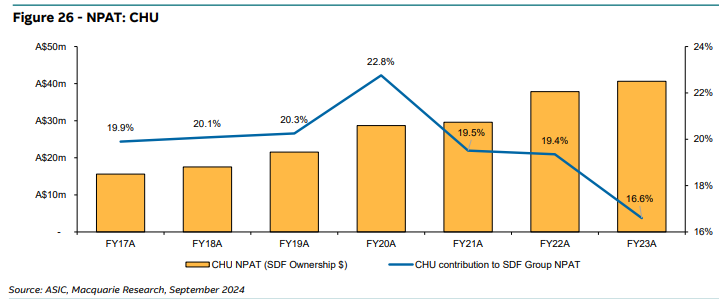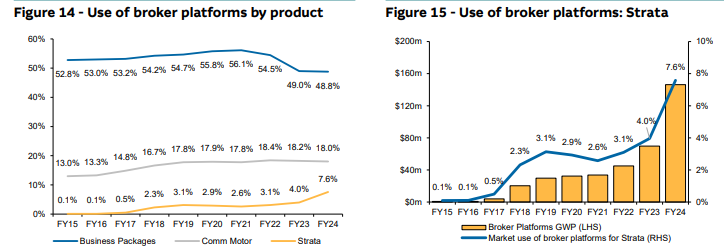Comprehensive report into strata insurance
$6.80 Price Target

The CHU factor: We estimate CHU (owned by SDF, capacity with QBE) had a ~43% market share in FY24 (down from ~50% in FY22). This is significant given we estimate Australian Strata risks are now one of QBE Group's top-three catastrophe exposures, and would be adversely affecting the cost of their Group reinsurance covers. In response, QBE has purchased a ~12.5% Quota Share, and will exit the Flex business, whilst also picking up lower share on SDF's contestable platform. As a result, new entrants such as Hutch are quickly picking up share, and with Sure recently changing its capacity to AXA XL (from Liberty), customers appear likely to receive more choice going forward.
...
IAG and SUN’s market-share losses align with their strategies to pull back from a product that earned sub-optimal returns for a long period of time
QBE (via the CHU agency) effectively became the buyer of last resort in FY22, but this began to turn in FY23 as Lloyds and Allianz capacity begun taking share. In the last 12 months, Hutch has entered the market and Sure Underwriting Agency changed its Strata capacity to AXA XL (from Liberty), thus we expect CHU's market share to continue to contract in FY25. Overall, the additional competition should be good for customers and assist brokers to source three quotes
....
We estimate ~25% of CHU's GWP is up for renegotiation in CY24/25. Þ If we assume a fixed-cost base for CHU, should a quarter of the 25% of GWP be redirected away from CHU (~7% of the total), we estimate this could equate to ~4.7% of SDF Group EPS in FY23, excluding the impact to SDF's Strata brokers (e.g., BAC and BCB). Having said that, to our understanding, all contracts have been retained thus far.
Use of broker platforms is significantly below that of Business Package, or even Commercial Motor products, because very few broker platforms have a Strata offering. This adds to the inefficiencies across the broker market

Outlook • The Strata market is likely to continue to garner negative press over the medium term, spurred by affordability challenges. Ongoing uplift of disclosure in NSW is already in train, and we would expect this to follow in other states. For brokers, the pathway to improvement has been outlined in the Trowbridge report for some time, and we expect media attention to be the catalyst for industry-wide change
...
Appendix A: What is Strata insurance? • Strata insurance typically covers a building, as well as contents/property in common areas (as defined on the title of the property) in the event of loss or damage. Strata insurance must also include liability cover in the event people are injured on common property. This form of insurance is compulsory under each Australian state’s legislation for both residential and commercial Strata properties.
Volumes: Asset volume growth has been very strong due to: #1) a construction boom pre-Covid in Australia and #2) migration towards more urban living pre-COVID. This supported ~3.8% growth pa of Strata schemes nationally over 2018-20. Þ According to a University of NSW study in 2022, nearly 10% of Australians and almost 14% of households live in apartments.
• Pricing: Price rises have been consistently strong, ranging mostly 8%-12% on average between 2018 and 2021, accelerating until Dec '22, and now stabilising at 14%-17%. Pricing was led by reinsurance costs, claims cost inflation and higher distribution costs. Looking forward, we believe the reset of sums insured and higher regulatory costs will lead prices higher, while the Rate On Line could stabilise.




